Initial Reaction
Today’s establishment survey was a stronger than expected 222,000. Upward revisions added a net 47,000 jobs in April and May.
In the household survey, employment fell by 233,000 in May and rose by 245,000 in June.
The unemployment rate went up because the labor force rose more than employment.
Despite the job increases, private earnings rose only 0.18 percent in June and that is from downward revisions in May. Year-over-Year, private earnings are up only 2.3%.
Let’s dive into the details in the BLS Employment Situation Summary, unofficially called the Jobs Report.
BLS Jobs Statistics at a Glance
- Nonfarm Payroll: +222,000 – Establishment Survey
- Employment: +245,000 – Household Survey
- Unemployment: +116,000 – Household Survey
- Involuntary Part-Time Work: +107,000 – Household Survey
- Voluntary Part-Time Work: -229,000 – Household Survey
- Baseline Unemployment Rate: +0.1 to 4.4% – Household Survey
- U-6 unemployment: +0.2 to 8.6% – Household Survey
- Civilian Noninstitutional Population: +190,000
- Civilian Labor Force: +361,000 – Household Survey
- Not in Labor Force: -170,000 – Household Survey
- Participation Rate: +0.1 to 62.8 – Household Survey
Employment Report Statement
Total nonfarm payroll employment increased by 222,000 in June, and the unemployment rate was little changed at 4.4 percent, the U.S. Bureau of Labor Statistics reported today. Employment increased in health care, social assistance, financial activities,
and mining.
Unemployment Rate – Seasonally Adjusted
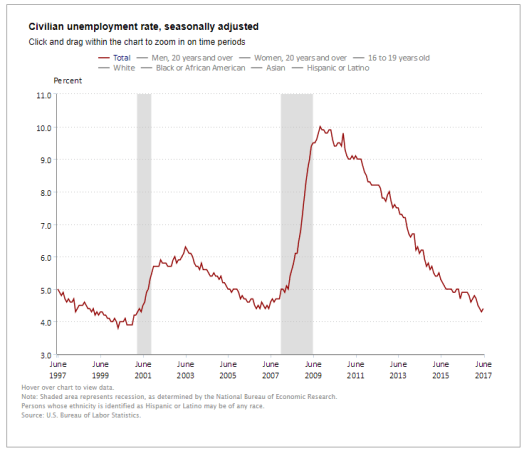
The above Unemployment Rate Chart is from the BLS.
Nonfarm Employment Change from Previous Month
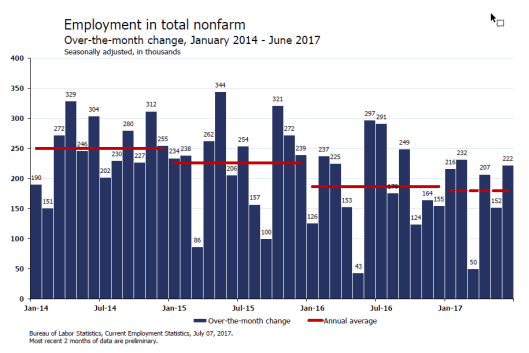
Nonfarm Employment Change from Previous Month by Job Type
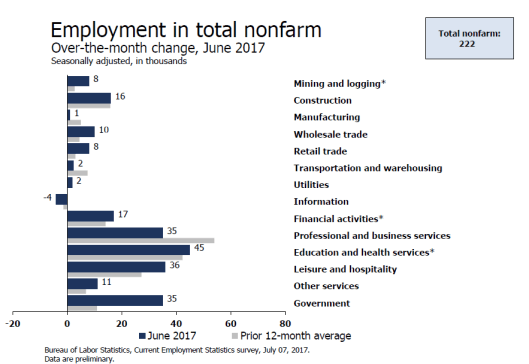
Hours and Wages
Average weekly hours of all private employees remained flat at 34.4 hours. Average weekly hours of all private service-providing employees remained flat at 33.3 hours. Average weekly hours of manufacturers rose 0.1 hours at 40.8 hours. All are the same or within 0.1 hours from a year ago.
Average hourly earnings of private workers rose $0.04 to $22.03 from a $0.01 downward revision in May. Average hourly earnings of private service-providing employees rose $0.04 to $21.79 from a $0.02 downward revision in May. Average hourly earnings of manufacturers remained flat at $20.78. However, the BLS revised May from $20.79 to $20.78.
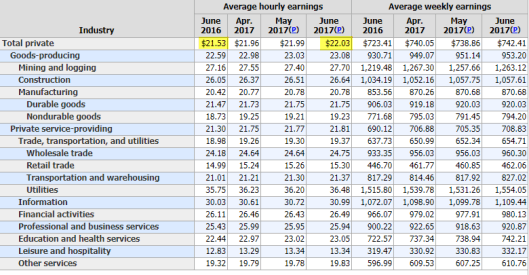
Birth Death Model
Starting January 2014, I dropped the Birth/Death Model charts from this report. For those who follow the numbers, I retain this caution: Do not subtract the reported Birth-Death number from the reported headline number. That approach is statistically invalid. Should anything interesting arise in the Birth/Death numbers, I will comment further.
Table 15 BLS Alternate Measures of Unemployment
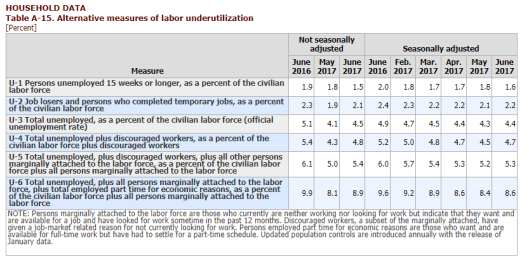
Table A-15 is where one can find a better approximation of what the unemployment rate really is.
Notice I said “better” approximation not to be confused with “good” approximation.
The official unemployment rate is 4.4%. However, if you start counting all the people who want a job but gave up, all the people with part-time jobs that want a full-time job, all the people who dropped off the unemployment rolls because their unemployment benefits ran out, etc., you get a closer picture of what the unemployment rate is. That number is in the last row labeled U-6.
U-6 is much higher at 8.6%. Both numbers would be way higher still, were it not for millions dropping out of the labor force over the past few years.
Some of those dropping out of the labor force retired because they wanted to retire. The rest is disability fraud, forced retirement, discouraged workers, and kids moving back home because they cannot find a job.
Strength is Relative
It’s important to put the jobs numbers into proper perspective.
- In the household survey, if you work as little as 1 hour a week, even selling trinkets on eBay, you are considered employed.
- In the household survey, if you work three part-time jobs, 12 hours each, the BLS considers you a full-time employee.
- In the payroll survey, three part-time jobs count as three jobs. The BLS attempts to factor this in, but they do not weed out duplicate Social Security numbers. The potential for double-counting jobs in the payroll survey is large.
Household Survey vs. Payroll Survey
The payroll survey (sometimes called the establishment survey) is the headline jobs number, generally released the first Friday of every month. It is based on employer reporting.
The household survey is a phone survey conducted by the BLS. It measures unemployment and many other factors.
If you work one hour, you are employed. If you don’t have a job and fail to look for one, you are not considered unemployed, rather, you drop out of the labor force.
Looking for jobs on Monster does not count as “looking for a job”. You need an actual interview or send out a resume.
These distortions artificially lower the unemployment rate, artificially boost full-time employment, and artificially increase the payroll jobs report every month.
Final Thoughts
We got a stronger bounce in employment than I expected. Nonetheless, there is a clear weakening pattern pattern from year to year.
More significantly, weak wage growth has not keep up with inflation, despite the BLS purporting otherwise.
This material is based upon information that Sitka Pacific Capital Management considers reliable and endeavors to keep current, Sitka Pacific Capital Management does not assure that this material is accurate, current or complete, and it should not be relied upon as such.
Recommended Content
Editors’ Picks
EUR/USD regains traction, recovers above 1.0700

EUR/USD regained its traction and turned positive on the day above 1.0700 in the American session. The US Dollar struggles to preserve its strength after the data from the US showed that the economy grew at a softer pace than expected in Q1.
GBP/USD returns to 1.2500 area in volatile session

GBP/USD reversed its direction and recovered to 1.2500 after falling to the 1.2450 area earlier in the day. Although markets remain risk-averse, the US Dollar struggles to find demand following the disappointing GDP data.
Gold holds around $2,330 after dismal US data

Gold fell below $2,320 in the early American session as US yields shot higher after the data showed a significant increase in the US GDP price deflator in Q1. With safe-haven flows dominating the markets, however, XAU/USD reversed its direction and rose above $2,340.
XRP extends its decline, crypto experts comment on Ripple stablecoin and benefits for XRP Ledger

Ripple extends decline to $0.52 on Thursday, wipes out weekly gains. Crypto expert asks Ripple CTO how the stablecoin will benefit the XRP Ledger and native token XRP.
After the US close, it’s the Tokyo CPI

After the US close, it’s the Tokyo CPI, a reliable indicator of the national number and then the BoJ policy announcement. Tokyo CPI ex food and energy in Japan was a rise to 2.90% in March from 2.50%.